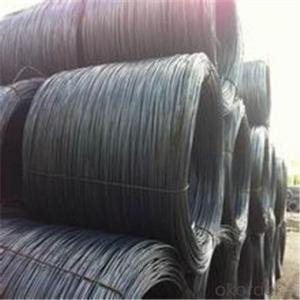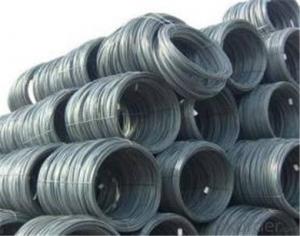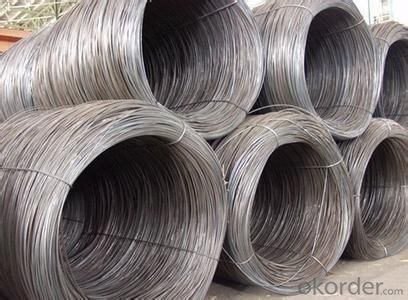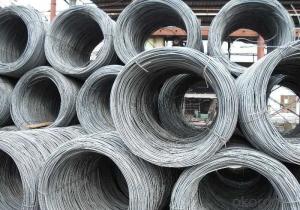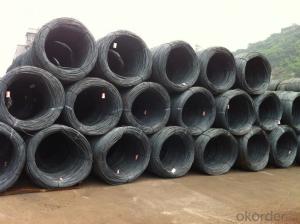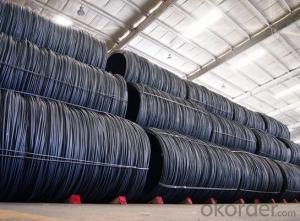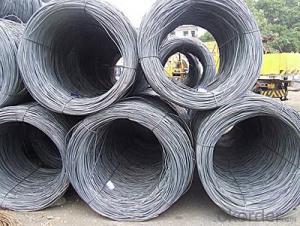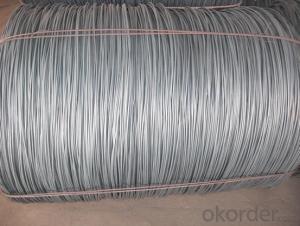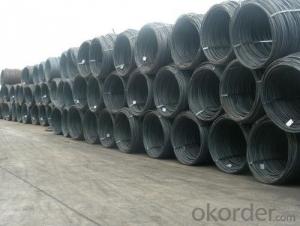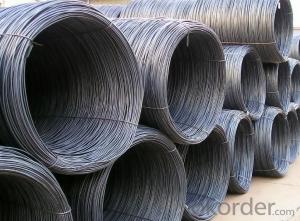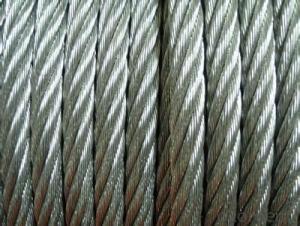Hot Rolled Steel Wire Rod 5.5mm with in China
- Loading Port:
- Shanghai
- Payment Terms:
- TT OR LC
- Min Order Qty:
- 500 m.t.
- Supply Capability:
- 45555555 m.t./month
OKorder Service Pledge
OKorder Financial Service
You Might Also Like
Specification
Description of wire Rod:
Diameter: 5.5mm,6.5mm,8mm,9mm,10mm,11mm,12mm
Grade:SAE1006/1008/1010/1012 /1015/1018
Coil weight:about 2 tons
Festures of wire Rod:
avaiable minimum order quantity: 25Tons for one size;
special size minumu quantity order: like 7mm, 9mm,11mm,3000Tons for one size;
application: concrete construction field;
torerance of thickness:±5%
Specifications of wire Rod:
Product | steel wire rod |
Standard | AISI, ASTM, BS, DIN, GB, JIS |
Material/steel grade | Q195-Q235,SAE1006, SAE1008, SAE1010, SAE1018, SAE1020 or according to customers requirements |
Wire Gauge | 5.5-12mm |
Coil weight | 1.8-2.1mts |
MOQ | 25MT |
Delivery Time | 15-30 days after receipt of L/C or deposit by T/T |
Packing | In coil and load in container, if large quantity, by bulk vessel; Can be packed as customers' special requirements |
Payment terms | 1).100% irrevocable L/C at sight. |
Application | widely used in machinery parts |
Images of wire Rod:
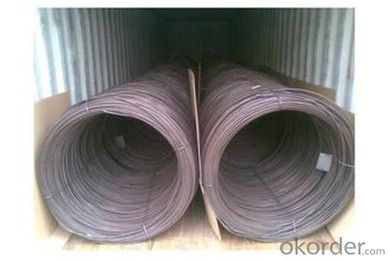
FAQ:
1. What is your package?
Packing situation: standard seaworthy packing or as customer required.
2. How long is the lead time?
Delivery time: 45 days after order confirmed.
- Q: How is steel wire rod used in the manufacturing of paper clips?
- Steel wire rod is used in the manufacturing of paper clips as it serves as the primary material for creating the staple-like shape of the clip. The rod is shaped, cut, and bent into the desired form of a paper clip, providing the necessary strength and flexibility to securely hold papers together.
- Q: How is steel wire rod recycled at the end of its lifecycle?
- Steel wire rod can undergo steel scrap recycling at the end of its lifecycle. This involves a number of steps to transform the wire rod into reusable steel materials. To begin the recycling process, steel wire rod scraps are collected from various sources such as manufacturing waste, construction materials, or end-of-life products like old cars or appliances. Once collected, the scraps are sorted and separated based on their composition and quality. The sorted steel wire rod scraps are then sent to a recycling facility where they are shredded into smaller pieces to facilitate further processing. Shredding can be done using different methods, such as hydraulic shears or industrial shredders. After shredding, the steel wire rod pieces undergo magnetic separation to remove any non-ferrous materials like plastic or rubber that may be mixed with the scraps. Magnetic separators attract and remove these non-ferrous materials, leaving behind the steel wire rod pieces. The separated steel wire rod pieces are further processed to remove impurities or contaminants. This is done through a process called melting, where the wire rod pieces are heated to extremely high temperatures in a furnace. This melting process burns off or skims off any impurities or contaminants from the molten metal. Once the impurities are removed, the molten steel is poured into molds to form new steel products. The molds can vary depending on the desired shape and size of the final product. After the steel has solidified, it can be further processed and treated to meet specific requirements, such as tempering or strengthening. The recycled steel wire rod can be used as raw material in industries like construction, automotive manufacturing, and appliance production. This reduces the need for extracting and refining virgin iron ore, which conserves natural resources and minimizes environmental impact. In conclusion, steel wire rod is recycled through a series of steps including collection, sorting, shredding, magnetic separation, melting, molding, and further processing. This process allows the steel to be reused in various industries, promoting sustainability and reducing the demand for new steel production.
- Q: How is steel wire rod packaged for transportation and storage?
- Steel wire rod is typically packaged in a manner that guarantees its protection and ease of handling during transportation and storage. To achieve this, a series of steps are taken to ensure the product's safety and integrity. Typically, steel wire rod is bundled together using steel straps or wires. These bundles are tightly secured to prevent any movement or damage while being transported. The size and weight of these bundles may vary depending on the specific requirements and dimensions of the wire rods. To offer further protection against external factors like moisture, dust, and corrosion, it is common to coat the wire rod with a layer of oil or other rust-resistant material. This coating helps maintain the wire rod's quality and durability while in storage or during transportation. The bundles of steel wire rod are then stacked and stored in a warehouse or on a pallet. This method ensures easy handling and efficient use of space. The pallets, made from wood, plastic, or metal, are designed to withstand the weight and pressure of the wire rod bundles. Additionally, they facilitate the use of forklifts or other lifting equipment for loading and unloading purposes. During transportation, steel wire rod is typically loaded onto trucks, trains, or ships for long-distance travel. Proper lifting equipment is employed during the loading and unloading process to ensure the bundles' safety and integrity. The wire rod bundles are securely fastened and secured to prevent any movement that could potentially cause damage. In summary, the packaging of steel wire rod for transportation and storage involves securely bundling, applying a protective coating, stacking and storing on pallets, and using appropriate lifting equipment. These measures are essential in guaranteeing the wire rod's safety, quality, and integrity throughout its journey from the manufacturing facility to its final destination.
- Q: What are the environmental impacts of steel wire rod production?
- The environmental impacts of steel wire rod production include the release of greenhouse gases during the manufacturing process, such as carbon dioxide emissions from the combustion of fossil fuels. Additionally, the extraction and processing of raw materials, such as iron ore and coal, can lead to deforestation, habitat destruction, and air and water pollution. Steel wire rod production also requires significant amounts of energy, contributing to the consumption of non-renewable resources and potentially increasing the use of fossil fuels. Proper waste management and pollution control measures are essential to mitigate these environmental impacts.
- Q: How is steel wire rod used in the manufacturing of fishing lines?
- The manufacturing of fishing lines commonly utilizes steel wire rod because of its strength, durability, and flexibility. Steel wire rod is capable of withstanding the tension and pressure exerted by large fish, making it ideal for deep-sea and heavy-duty fishing. To produce fishing lines, steel wire rod undergoes a process of being drawn into a thin and fine wire. A layer of protective material, such as nylon or polymer, is then applied to the wire to enhance its resistance to corrosion and provide a smooth surface for casting and reeling. The utilization of steel wire rod in fishing lines offers numerous advantages. Firstly, the high tensile strength of the steel wire ensures that the fishing line can endure the pulling force of a struggling fish, minimizing the risk of breakage. Additionally, the durability of steel wire rod reduces the likelihood of wear and tear, resulting in an increased lifespan and enhanced reliability of the fishing line. Furthermore, steel wire rod possesses exceptional flexibility, enabling the fishing line to be cast and reeled in easily. This flexibility allows anglers to accurately cast their lines with ease, thereby increasing the probability of a successful catch. Moreover, the flexibility of steel wire rod enables the fishing line to absorb sudden shocks or jerks, preventing it from snapping under pressure. In conclusion, steel wire rod is an indispensable component in the production of fishing lines due to its strength, durability, and flexibility. These properties enable fishing lines to withstand the tension exerted by fish, ensuring a higher success rate in catching fish while also enhancing the lifespan and reliability of the fishing line.
- Q: How is the machinability of steel wire rod determined?
- The machinability of steel wire rod is determined by various factors such as its chemical composition, microstructure, hardness, and surface finish. These characteristics affect the ease with which the wire rod can be cut, drilled, or machined. Additionally, factors like the cutting tool material and geometry, cutting speed, and feed rate also play a role in determining the machinability of steel wire rod. By considering these factors, manufacturers can evaluate and optimize the machinability of steel wire rod for specific applications.
- Q: What are the different impact testing methods for steel wire rod?
- There are several impact testing methods for steel wire rod, including the Charpy V-Notch (CVN) test, the Izod test, and the drop weight test. These tests measure the ability of the steel wire rod to withstand sudden impact or shock loading and provide valuable information about its toughness and resistance to fracture.
- Q: How is steel wire rod used in the production of wire mesh for automotive filters?
- Steel wire rod is used in the production of wire mesh for automotive filters by being drawn into thin wires, which are then woven together to create a durable and strong mesh structure. This wire mesh acts as a filter by trapping and preventing contaminants from entering the automotive system, ensuring clean air and fluid flow for optimal performance and engine protection.
- Q: How does the yield strength of steel wire rod vary with different wire drawing processes?
- The yield strength of steel wire rod generally increases with different wire drawing processes. Wire drawing involves pulling the rod through a die to reduce its diameter and increase its length. This process aligns the metal grains and elongates them, resulting in a more uniform and stronger structure. The higher the reduction ratio (the ratio of the initial diameter to the final diameter), the greater the increase in yield strength. Additionally, the use of heat treatments during or after wire drawing can further enhance the yield strength of the steel wire rod.
- Q: How is steel wire rod used in the manufacturing of wire rope pulleys?
- Steel wire rod is used in the manufacturing of wire rope pulleys as the primary material for the pulley's core construction. The steel wire rod is carefully formed and shaped to create the framework of the pulley, providing strength, durability, and flexibility required for its functioning. The wire rod's high tensile strength and resistance to wear and tear make it ideal for handling heavy loads and enduring rigorous usage in various applications that require wire rope pulleys.
Send your message to us
Hot Rolled Steel Wire Rod 5.5mm with in China
- Loading Port:
- Shanghai
- Payment Terms:
- TT OR LC
- Min Order Qty:
- 500 m.t.
- Supply Capability:
- 45555555 m.t./month
OKorder Service Pledge
OKorder Financial Service
Similar products
Hot products
Hot Searches
Related keywords
